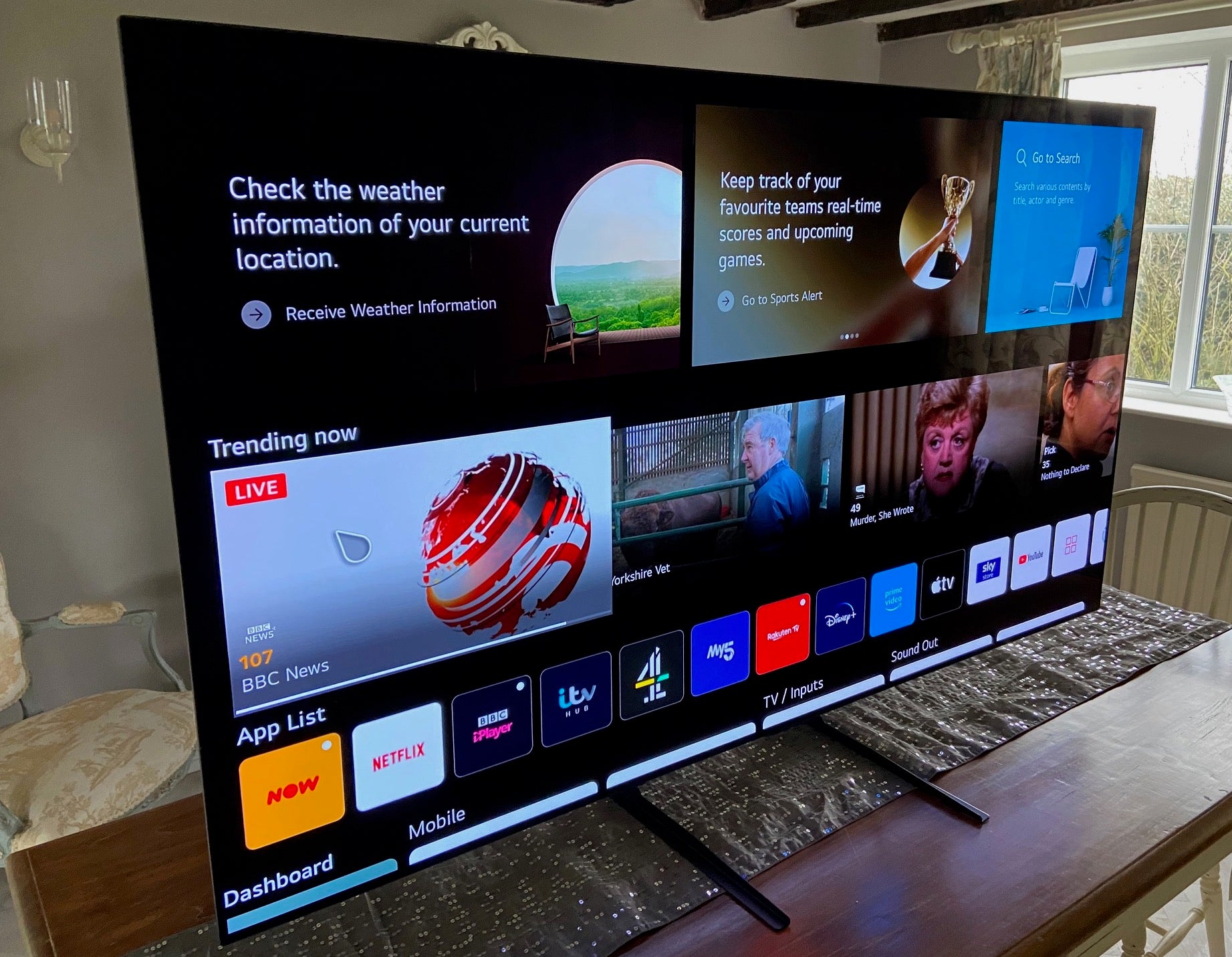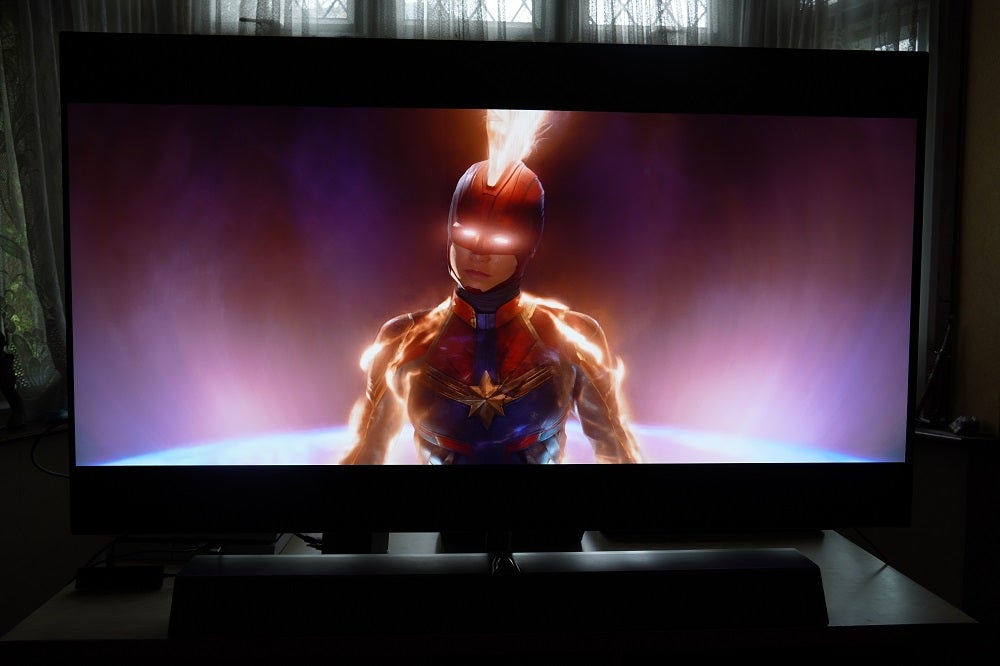LG OLED55G1 Review
The G1 OLED impresses with its fabulous picture quality
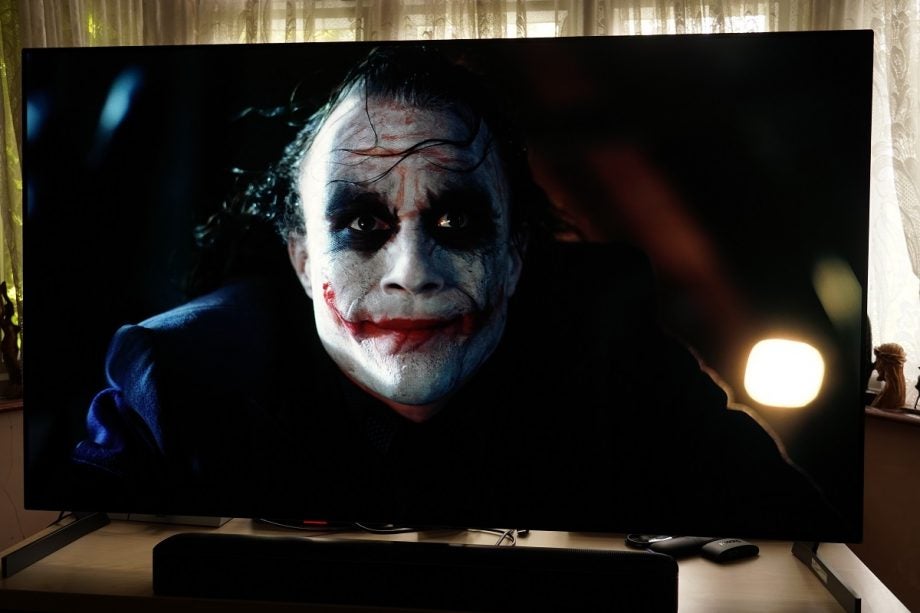

Verdict
The LG G1 is one of South Korean firm’s best OLEDs yet, from its minimalist design, fabulous picture quality and extensive features (gaming, in particular), this display oozes quality. Its preoccupation with wall-mounting means it isn’t for everyone, but this is another high-quality TV from LG.
Pros
- Sensational picture quality
- Attractive design
- Excellent upscaling abilities
- Dolby Vision + Atmos support
- Superb for gaming
- Simpler menu design
Cons
- Okay sound
- Motion processing isn’t as good as some rivals
- Made primarily to be wall-mounted
Key Features
- Evo OLED panelNew display nudges peak HDR brightness up
- VRR gamingWide-ranging gaming support includes Nvidia and AMD VRR
- α9 Gen 4 AI ProcessorNew AI features for picture and sound
- webOS 6.0Redesigned remote and refreshed look to webOS UI
Introduction
OLED TVs have almost become synonymous with LG. The South Korean electronics brand produces the panels that feature in every OLED on the market, and with the LG G1 (OLED55G1), it’s aiming to evolve its own OLEDs further.
With the launch of the G1 Gallery OLED, LG has introduced underlying panel technology to encourage more brightness. This ‘Evo OLED panel’ is exclusive to the G1, which should differentiate it from the C1 – as previous years had seen picture parity between the C-series and G-series.
Critics of OLED TVs point to its limited brightness. How far does the LG G1 go to improving the situation?
Availability
- UKRRP: £1999
- USARRP: $2199
- EuropeRRP: €2399
- CanadaRRP: CA$3497
- AustraliaRRP: AU$3799
The LG G1 OLED tested here is the 55-inch model (LG OLED55G16LA). There’s a 65-inch model (LG OLED65G16LA / £2999) and 77-inch G1 (LG OLED77G16LA / £4799). In the UK, these TVs are available online and in stores.
The 55-inch variant is priced at £1999 / $2199 / €2399 / CA$3497 / AUD$3799. There’s no 48-inch model in the Gallery OLED range. In terms of stands, there’s the LG Gallery Stand at an extra cost of £349, or desktop feet for £99.
In July LG will release the G1 soundbar, which is designed to partner the 55-inch G1. Pricing for that is £TBA. 2020’s GX soundbar is the audio companion for the 65-inch G1.
Design
- Great, minimalist looks
- New Magic Remote
- Designed for wall-mounting
Marketing about OLEDs usually focuses on the thinness of the screen, but the G1 is the first I’ve encountered where that holds true. OLED screens are slim, but the electronics, processors and speakers must go somewhere, and that means a bulge around the back.
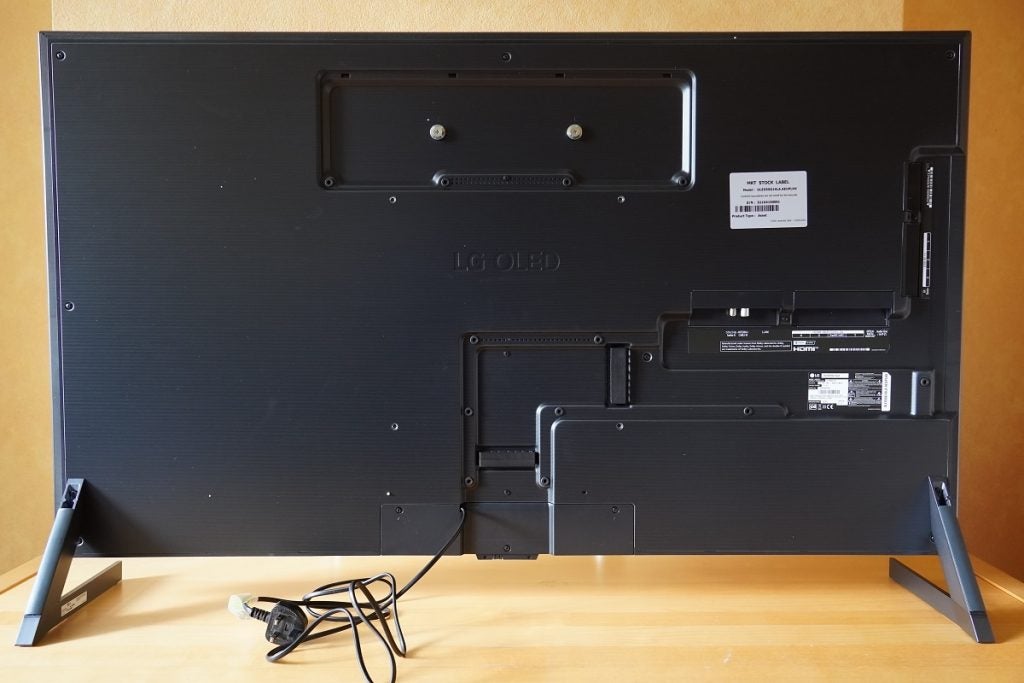
The LG G1 OLED has a depth of just 23.1mm and maintains that across the entirety of the rear, allowing it to sit flush against a wall. Given the G1 Gallery OLED is designed to be wall-mounted, you should bear that in mind before a purchase.
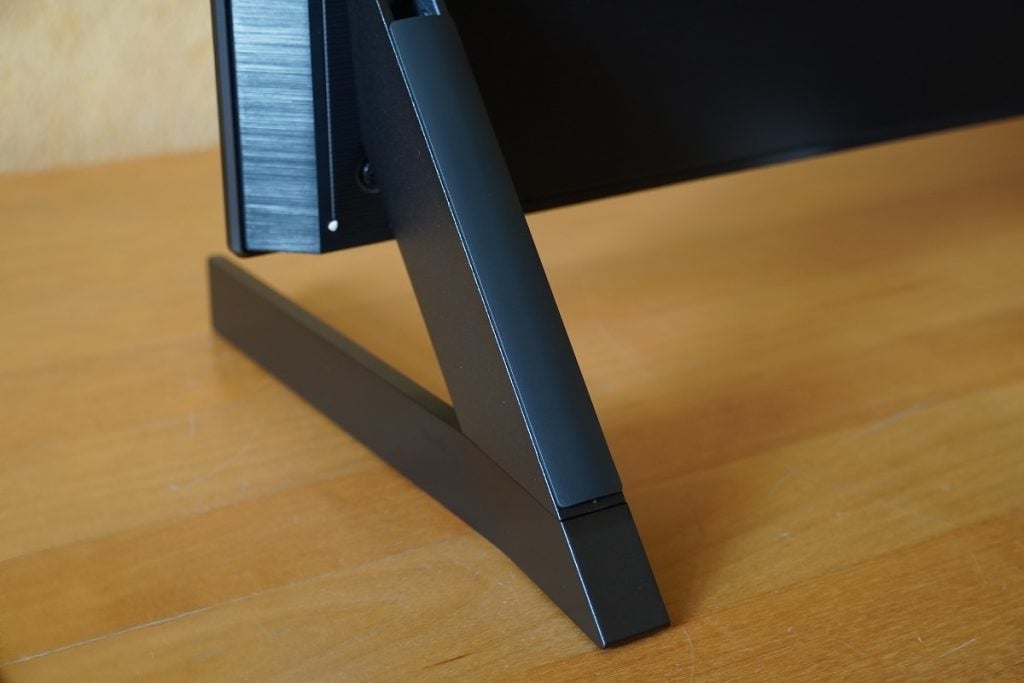
Wall brackets are included, but stands are optional. If you opt for the feet then there’s enough clearance for a soundbar beneath, while the Gallery Stand is for free-standing positioning.
Build quality is outstanding. The only aspect that lets the side down are the covers for the back panel, which feel (and look) flimsy when applied. The metallic-finished trim that encases the screen and thin bezel speaks to the high-quality of the G1’s construction. From any angle, the LG G1 is a handsome set.
Interface
- New remote
- Simpler menu interface
- Refreshed webOS UI
When it comes to the UI and remote, plenty has changed. The first redesign concerns the Magic Remote. In the past, I haven’t been too keen on the click-and-point nature, but this revised version feels more accurate and less prone to flashing across the screen with the merest flick of the wrist.
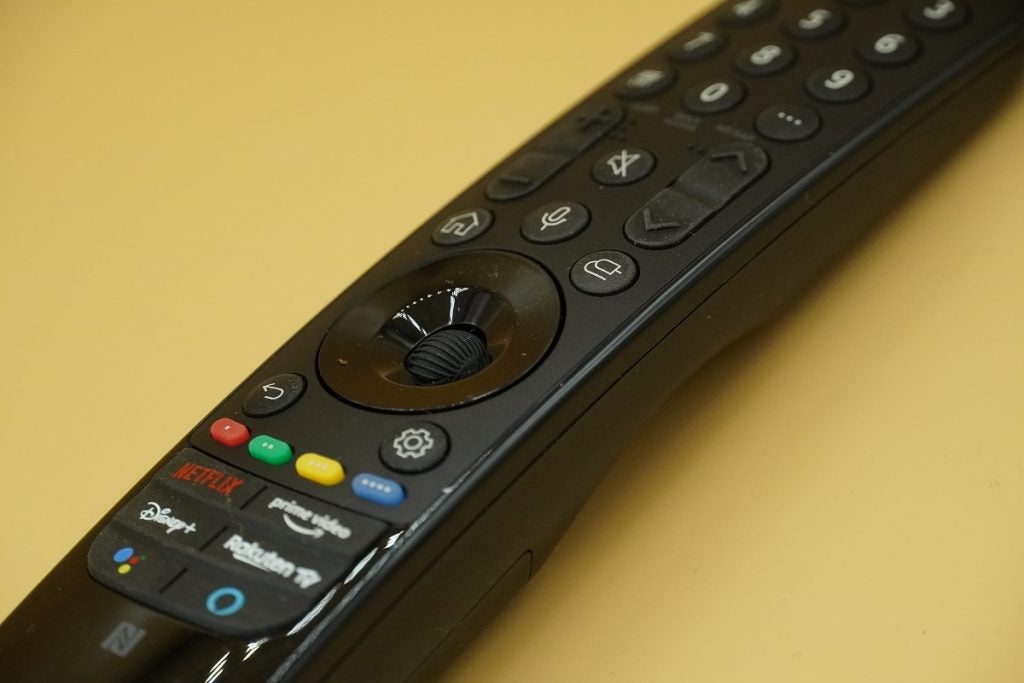
The remote comes loaded with hotkeys – LG says they vary for each territory – so the UK gets Netflix, Prime Video, Disney+, Rakuten TV, as well as Google Assistant and Alexa. As the main interaction with the TV, the new Magic Remote feels good in the hand. I have on occasion struggled with the scroll and click aspect of the centre button, but I think that’s more down to the remote being more suited for smaller digits.
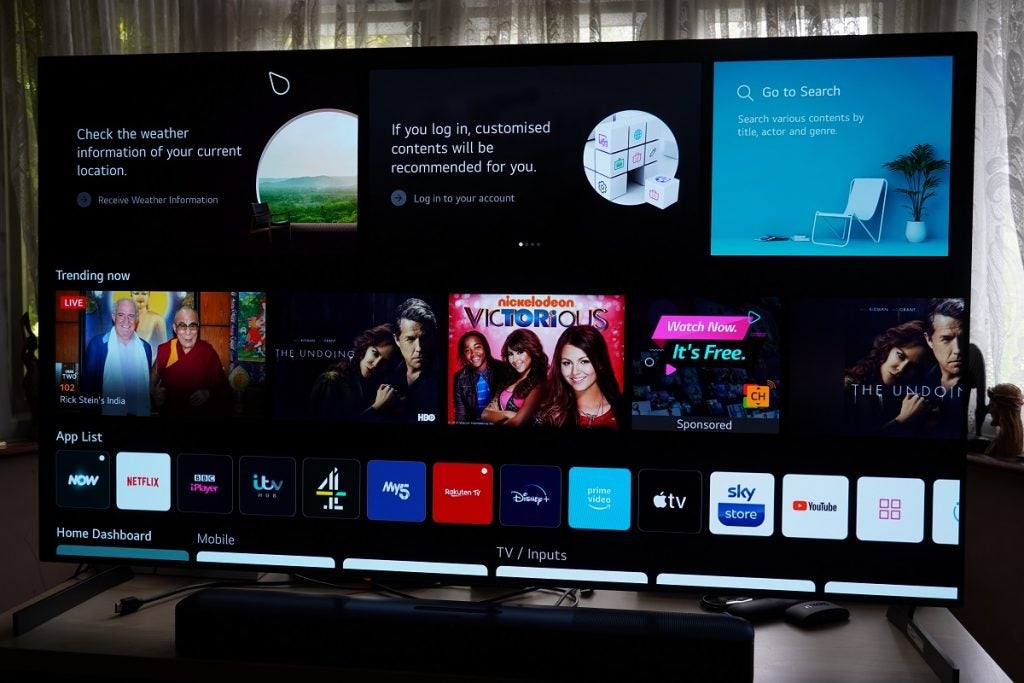
Pressing Home whisks the viewer away to a new hub page for webOS 6.0, although there are instances where the old app row does pop up. At the top are panels for weather info, a portal to create an LG account and Search. If you have no need for any of those then the top shelf lacks relevance.
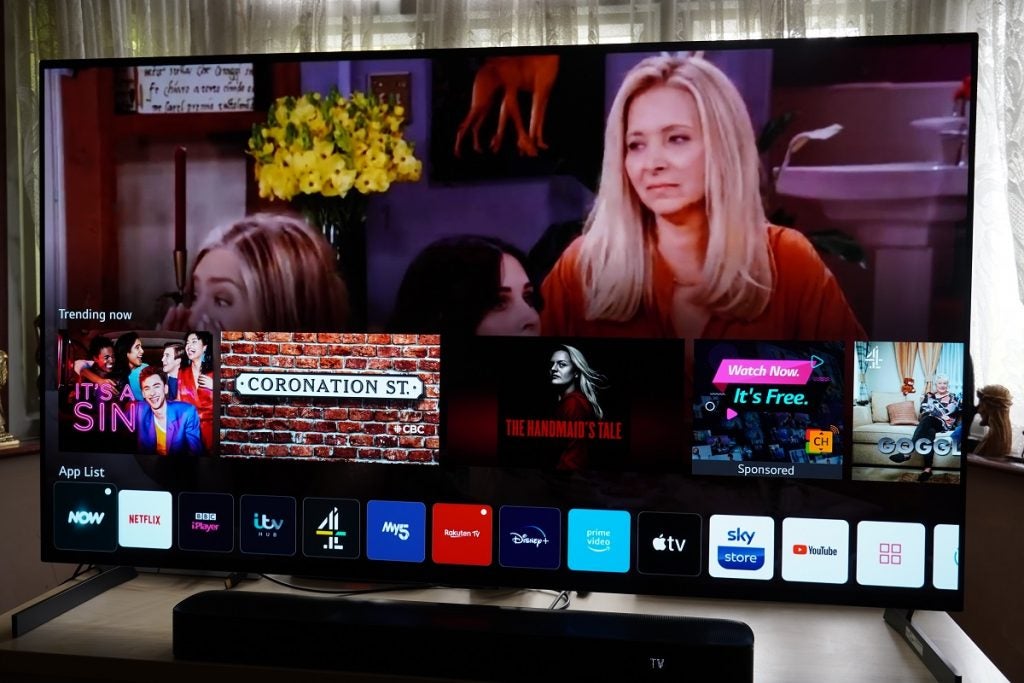
Below that is the ‘Trending Now’ bar: then the new position for the app list, a row of physical/digital inputs and smart connections, frequently viewed programmes (seems I enjoy Pointless), and rows of content from various apps: Rakuten, YouTube, iPlayer, ITV Hub and so on.
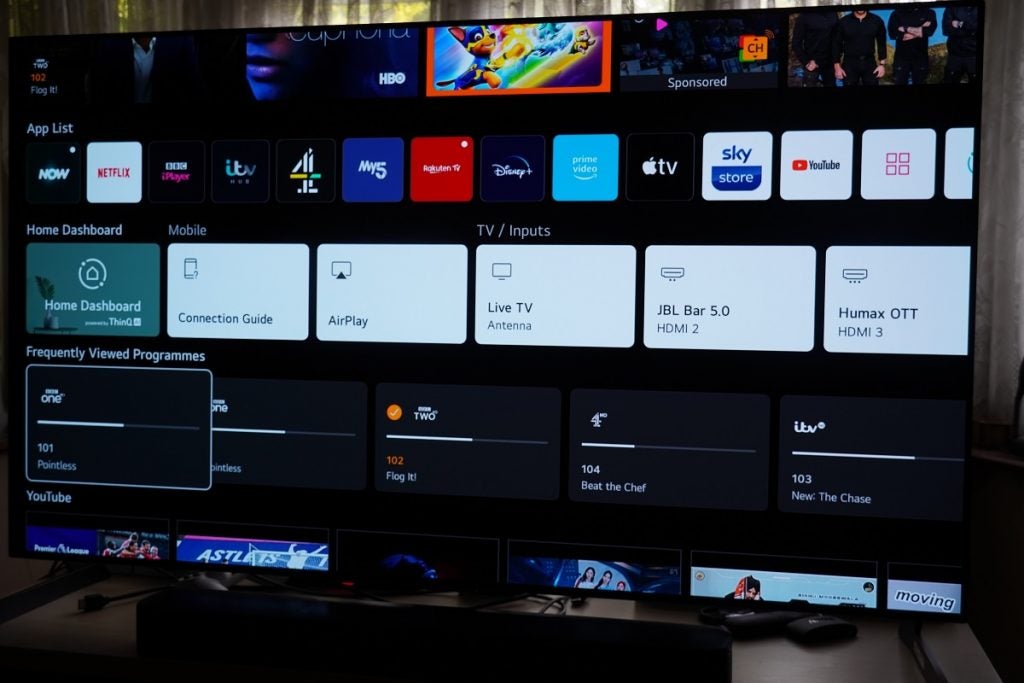
The webOS 6.0 hub offers an overview and means less clicks in general (which I’m all for); while the increase of hotkeys on the remote should slightly mitigate the lack of the pop-up bar. But the top shelf doesn’t feel like the best use of space, while having both a trending bar and rows of app-related content serves up a lot of content. It’s good if you like options, but I’m of the feeling of only populating those rows if you’ve logged into the respective app. It feels LG has tried to pack too much in.
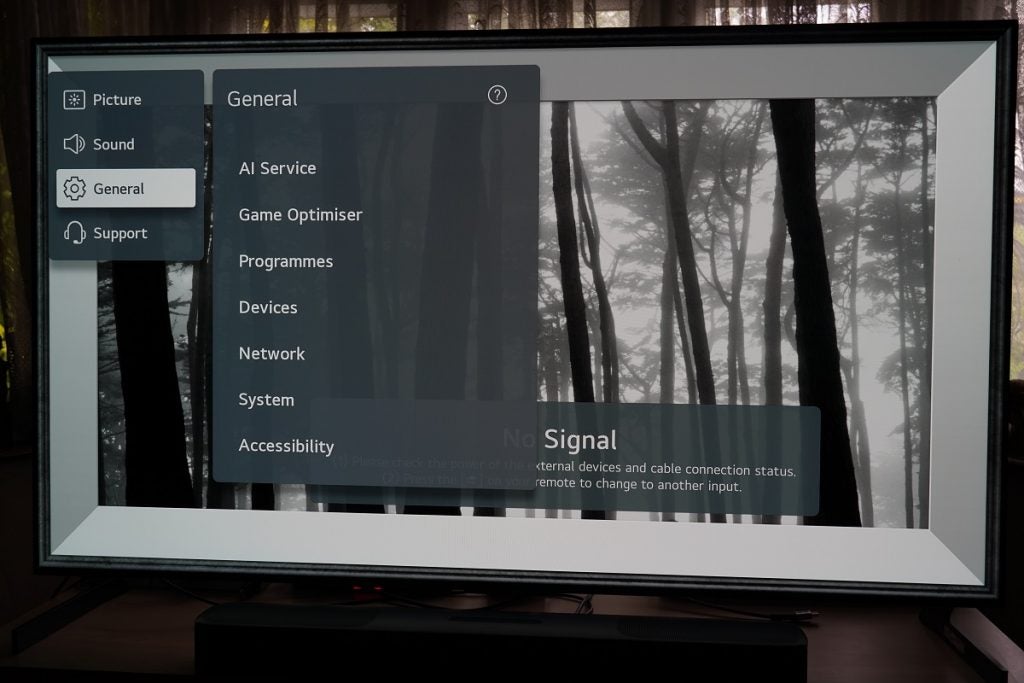
The third aspect of the UI redesign concerns the Menu system. It’s much simpler than before, divided into Picture, Sound, General (Settings) and Support. Helpful explanations are included for what each setting does, and it looks cleaner too.
Features
- Comprehensive gaming features
- Freeview Play returns
- Lots of smarts
2021 sees Freeview Play return after a year’s absence, with the UK catch-up TV apps and EPG present and correct in their little silo. The convenience Freeview Play offers is something potential TV buyers do look for.
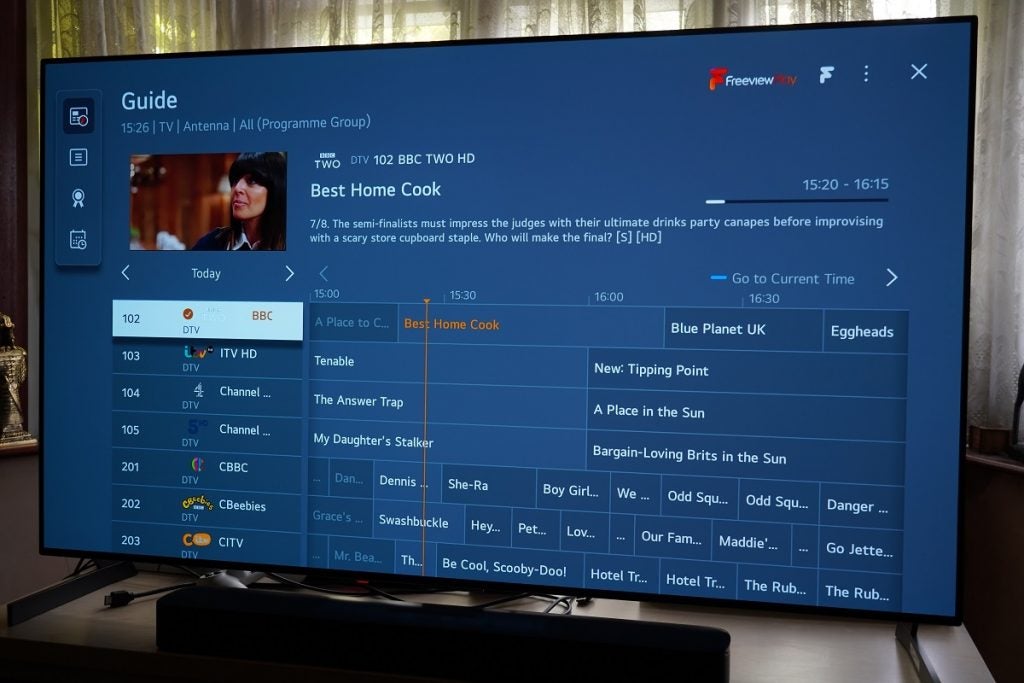
Burn-in and image retention are issues prospective buyers ought to be aware of with OLEDs. Image retention is temporary, but burn-in can be more permanent. Both are only a factor if the TV is driven hard over a prolonged period.
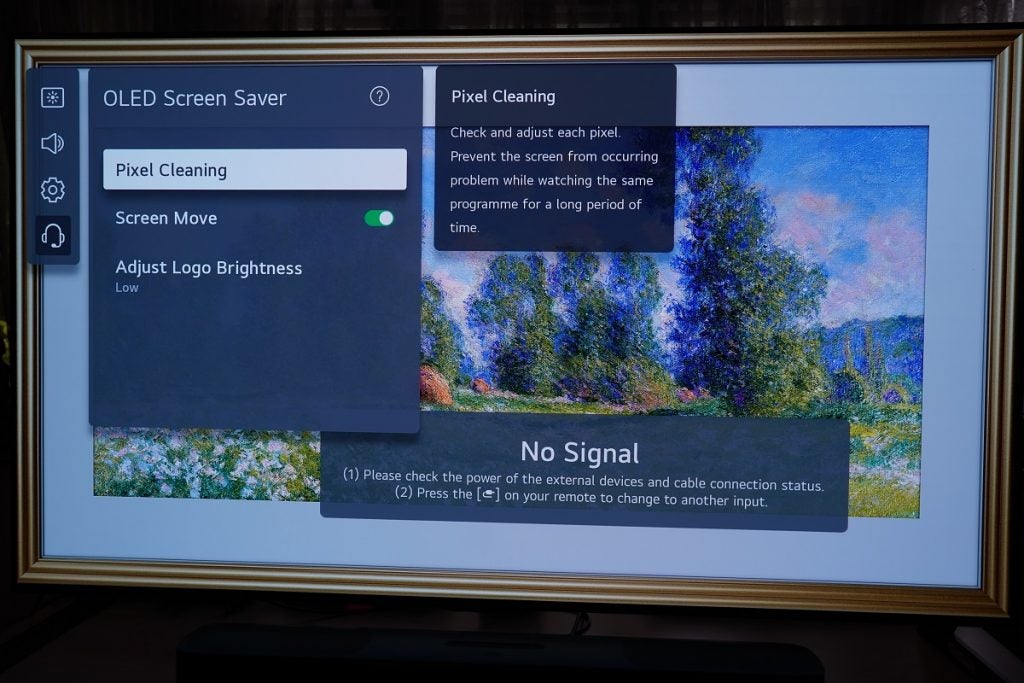
Images with static elements (logos, scoreboards, gaming UI) can cause this, and LG uses solutions such as Pixel Cleaning (which checks and adjusts each pixel), Screen Move (which moves the entire image slightly) and Logo Brightness (reduces logo and subtitles’ brightness automatically). If the TV is used responsibly – like any other – then neither burn-in and image retention should be a massive problem over the its lifespan.
Filmmaker mode preserves the creative intent of films and TV shows by disabling motion processing and other enhancements. It should be noted that Filmmaker mode reflects the environment a film was graded in, so it’s best viewed in darker rooms. FMM works across SDR, HDR10 and HLG formats.
FMM also supports auto-detection over HDMI or from a streaming app, so when it receives a FMM signal it will automatically pivot to the picture mode. As far as I can tell, there’s no content with the Filmmaker mode signal out there.
Still, watching La La Land and Interstellar in the mode produces slightly more accurate colours and ekes out a smidge more brightness over the Home Cinema picture mode. I dig it.
HOME CINEMA – – – – – – – – – – – – – – – – – – – – – – FILMMAKER


Dolby Vision IQ is also back. IQ uses the TV’s light sensor to analyse the ambient light in a room to optimise the colour, contrast and luminance for Dolby Vision HDR content. With no specific mode for the user to select, IQ works in tandem with the AI Brightness feature to optimise the image.
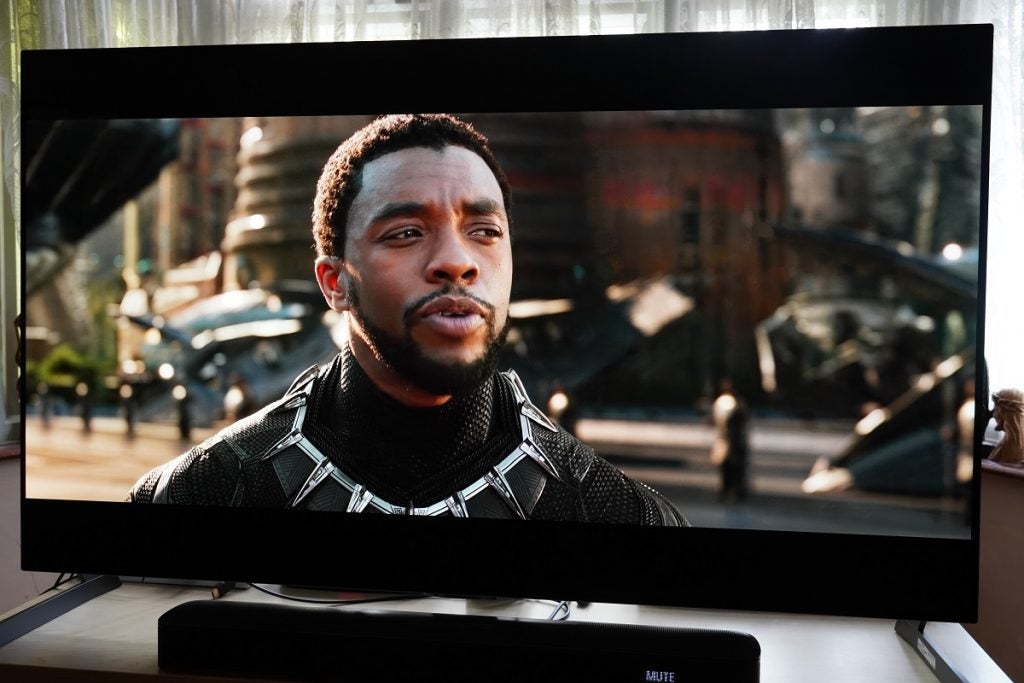
LG’s OLEDs are some of the most gaming-friendly TVs available. They’re the official TVs for the Xbox Series X and will be getting Google Stadia support sometime in 2021. For VRR (Variable Refresh Rate) it supports the standard version, along with Nvidia G-Sync and AMD FreeSync Premium.
Enabling VRR reduces latency, torn frames and flicker for a more responsive and fluid image. I didn’t notice any flicker, and with a 4K and 1080p lag tester I measured latency at 12.5ms – slightly faster than on the CX.
The speediness has a positive effect – reaction time for starts in Moto GP 2021 went from average to super-snappy, and control over the bike was more responsive to the point where it felt like I’d been handed an unfair advantage. LG says it’s possible to drive latency down to 9.6ms for 60Hz content in Boost mode, but it still worked out at 12.5ms.
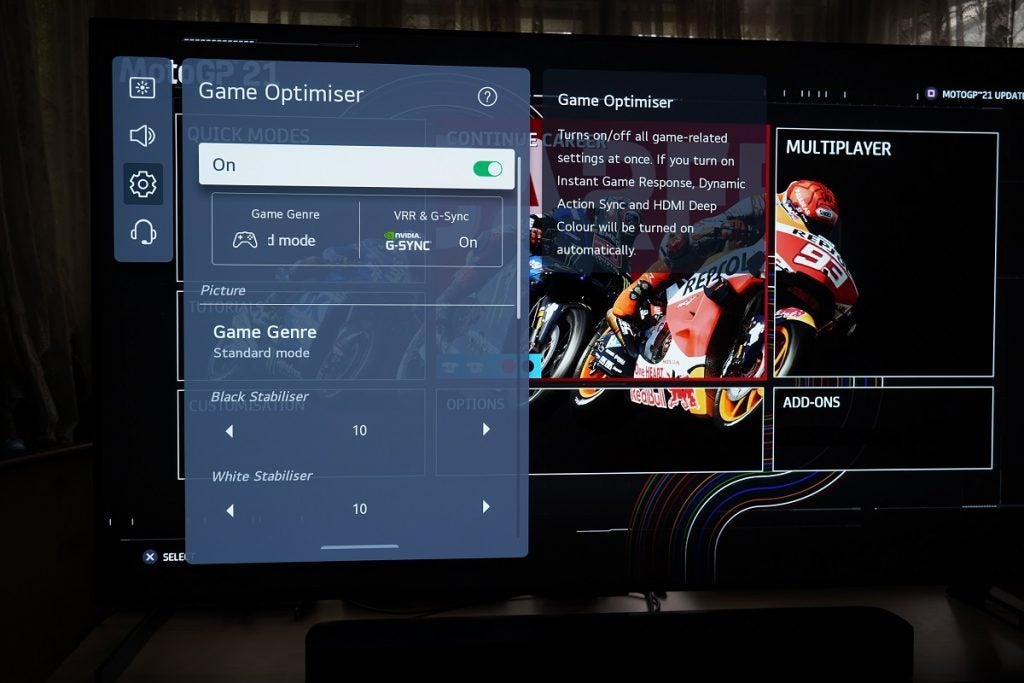
Other gaming features include Game Optimiser, which is a hub for the TV’s various gaming settings. 4K/120Hz High Frame Rate (HFR) is available across all HDMI inputs, so you can plug however many consoles or PCs into any of the inputs. It isn’t yet confirmed whether LG’s OLEDs will support 4K/120Hz with Dolby Vision for gaming.
There’s Auto Low Latency Mode (ALLM) for automatically putting the TV into its Game mode when it detects a gaming signal, while the HGiG standard improves HDR tone-mapping for a more consistent performance. I did notice more detail in the darker parts of an image than I remember seeing before.
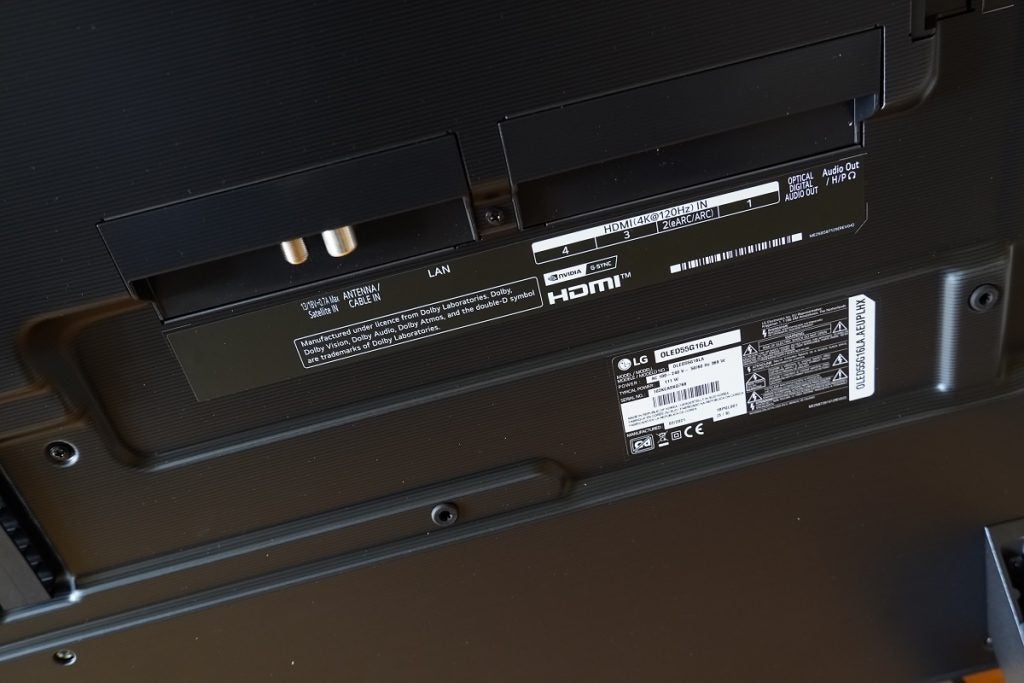
Connections amount to four HDMI 2.1 inputs (40Gbps of bandwidth), a headphone out, Digital optical out, an Ethernet socket, satellite and aerial inputs, three USB, and a CI+ 1.4 (Common Interface) slot. HDMI 2 supports eARC for pass-through of lossless/higher-quality audio such as Dolby Atmos.
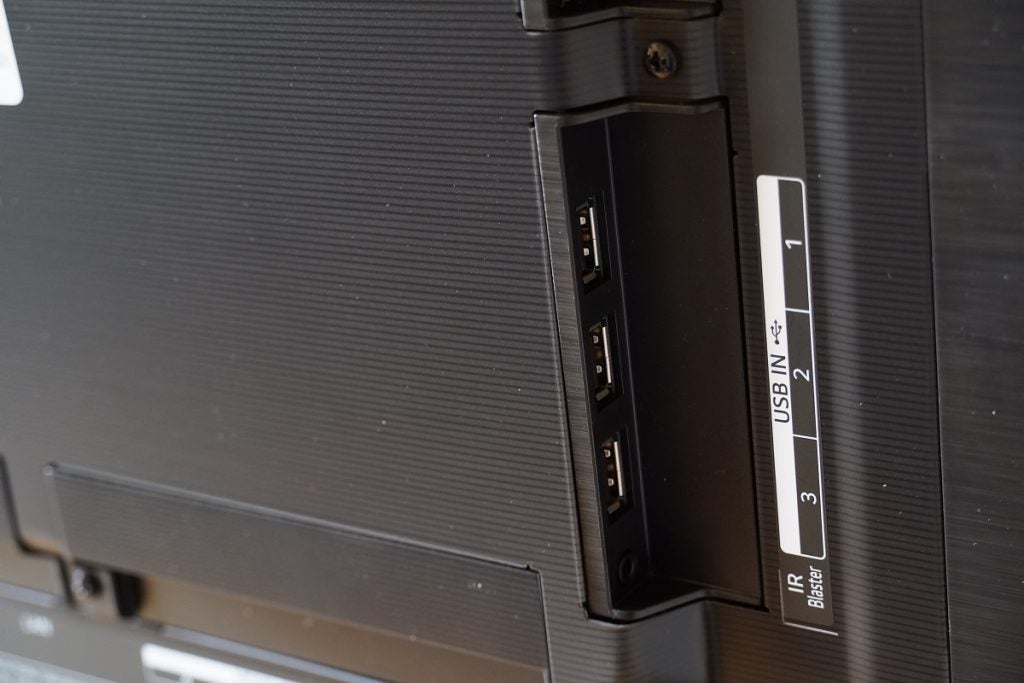
In broad terms, wireless connectivity is Wi-Fi and Bluetooth 5.0. More specifically, the LG G1 supports AirPlay 2, built-in Chromecast, WiSA (Wireless Speaker & Audio) and Bluetooth Surround Ready.
Finally, there are digital assistants in LG’s ThinQ service, Amazon’s Alexa and Google Assistant. Google Assistant sort of worked – the Google Home app on my smartphone couldn’t find the TV, but asking a few questions did retrieve answers from the TV.
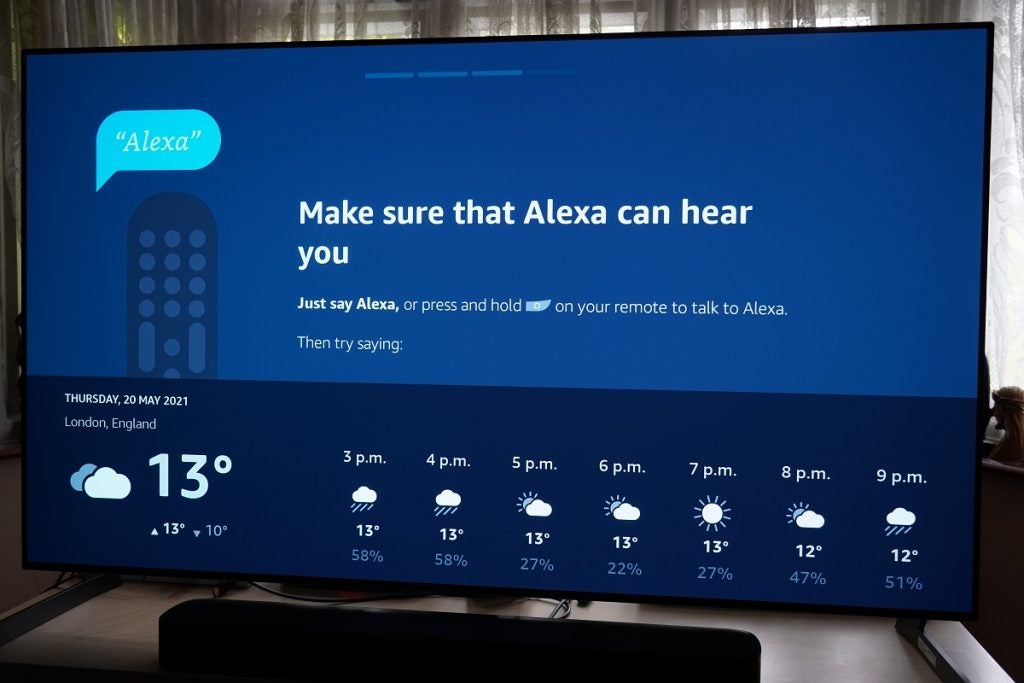
Alexa also worked with the few requests I lobbed at her – and, conveniently, I could call her up without using the remote. Both OK Google and Alexa were a little tardy in their responses, though.
Picture quality
- Consistently good, fabulously entertaining picture quality
- Out-of-box brightness settings require tweaking
- Evo panel adds a bit more intensity to HDR content
When it comes to picture quality, the LG G1 OLED produces an outstanding performance. The added brightness of the Evo panel isn’t orders of magnitude more, but the extra brightness yields a more… illuminating performance.
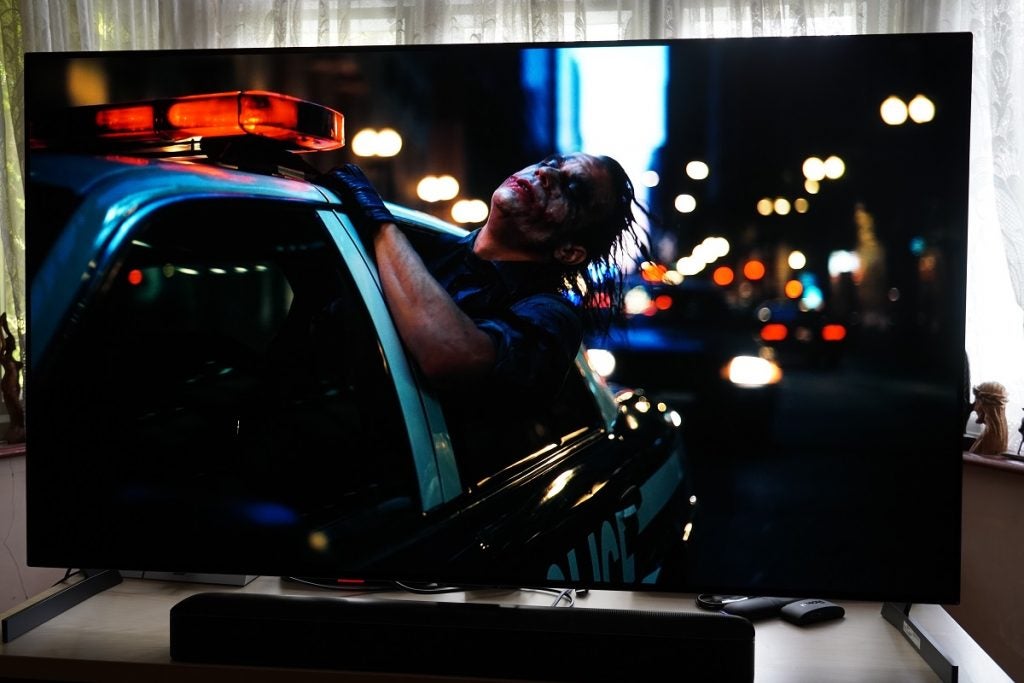
We’re onto the α9 Gen 4 AI processor and new features include Scene Detection and Object Enhancement. The former optimises a scene depending on its type, while the latter trains its focus on faces and objects to offer more definition.
Without a 2020 OLED to compare it to, it’s hard to make an exact judgement. However, the LG G1 proffers a very good sense of fine detail with faces (beards, stubble, crows feet and so on), with no particular softness or noise evident in problematic areas such as mouths or eyes – faces are full of character.
SD SDR – – – – – – – – – – – – – – – – – – – – – – – – – – – – – – – HD SDR

Colours in SDR content take a well-balanced and natural approach, with skin tones varied and tonally well done. Colours are deftly portrayed – there was barely an image that didn’t look effortlessly refined in its colour depth, hue and definition. It’s a lovely looking image.

Upscaling appears improved. HD images are sharply drawn (but not overly so), boasting excellent detail and a clean look. SD SDR drops in quality with predictable softness and lack of detail, but colours match their HD counterparts for accuracy, and there’s reasonably robust definition of edges too. Halos around objects and people feature far less than on the CX and, overall, the SD SDR image is surprisingly watchable.
SD SDR – – – – – – – – – – – – – – – – – – – – – – – – – – – – – – – HD SDR

If there’s one aspect where the G1 OLED gives something away, is that sense of punchiness QLEDs can deliver.
One area where the G1 isn’t as strong is motion. TruMotion offers five choices: Off, Cinematic Movement, Natural, Smooth Movement and User (for finer control over de-judder and de-blur settings).
Cinematic Movement offers a semblance of processing but keeps a relatively ‘cinematic’ look. Natural applies more processing, and Smooth Movement is the strongest option.
Watching the scene in 1917 (HDR10) where Lance Corporal Schofield runs across the field and there’s that slightly odd, fake cardboard 3D effect – the effect that plagued Ang Lee’s earlier high frame rate films – that hurts the naturalism of the G1’s images. Judder is visible with his legs, while the TV also struggles to bind its processing to hand movements. This effect is more noticeable the stronger the processing.
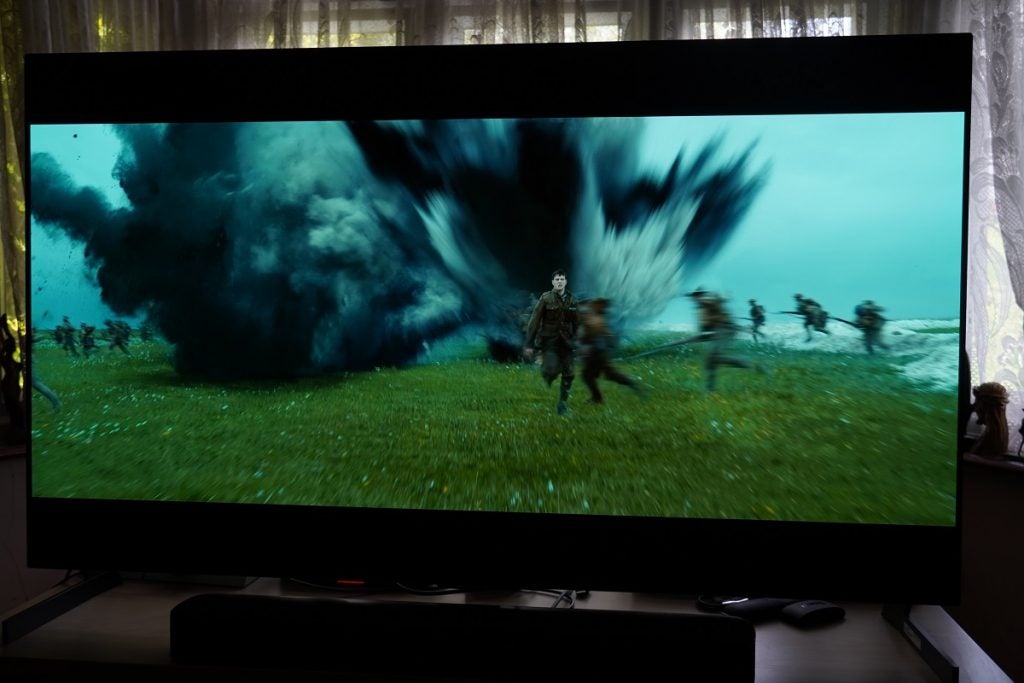
It also encounters trouble with panning shots, where K’s Spinner flies through the dreary Los Angeles landscape of Blade Runner 2049, for example, or where Persephone, Neo, Morpheus and Trinity walk through a kitchen in The Matrix Reloaded (4K HDR10). Motion presents smearing and an artificiality that’s at its strongest with the Smooth Movement option.
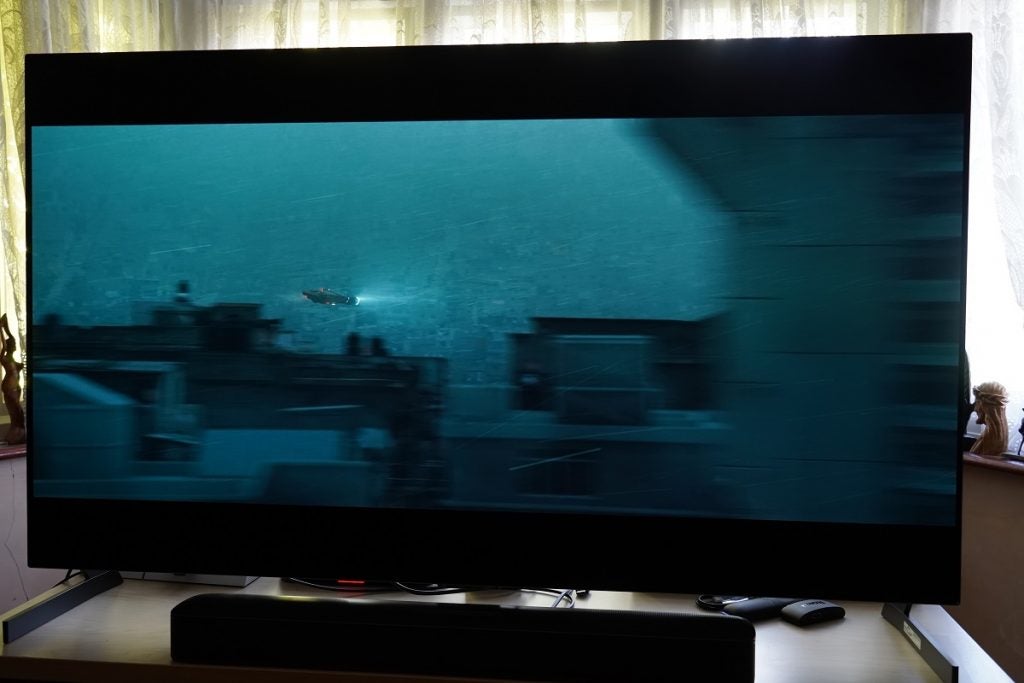
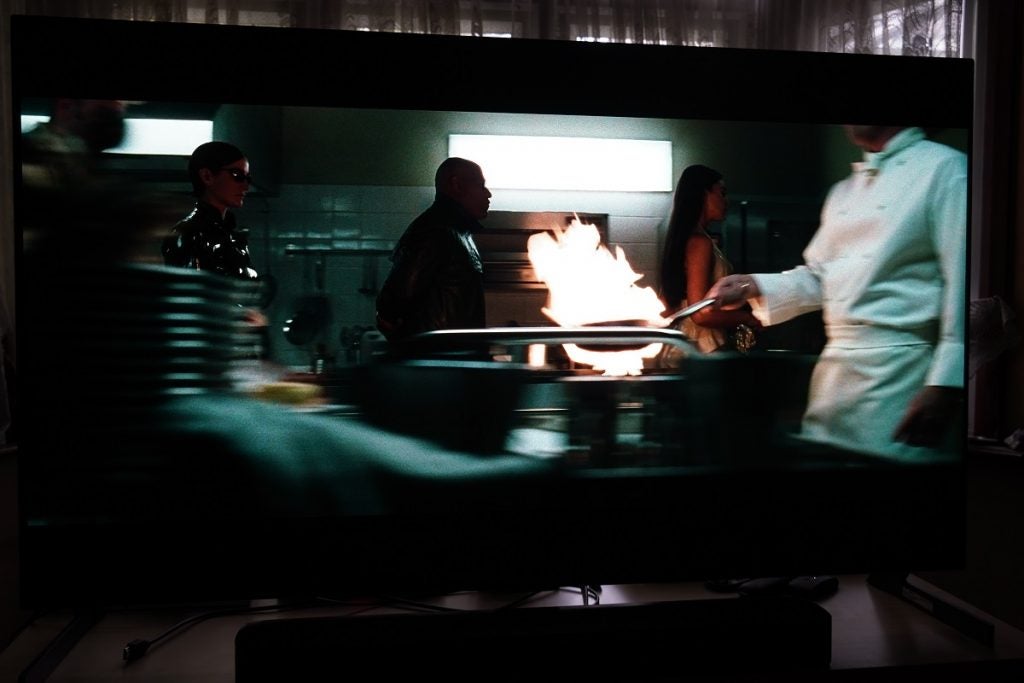
That said, there are instances where stronger TruMotion settings hit the spot. Watching the Spanish F1 Grand Prix on All 4 produced impressively grippy levels, ironing out the wrinkles in the image. With TruMotion off, the stutter of the broadcast was a distraction.
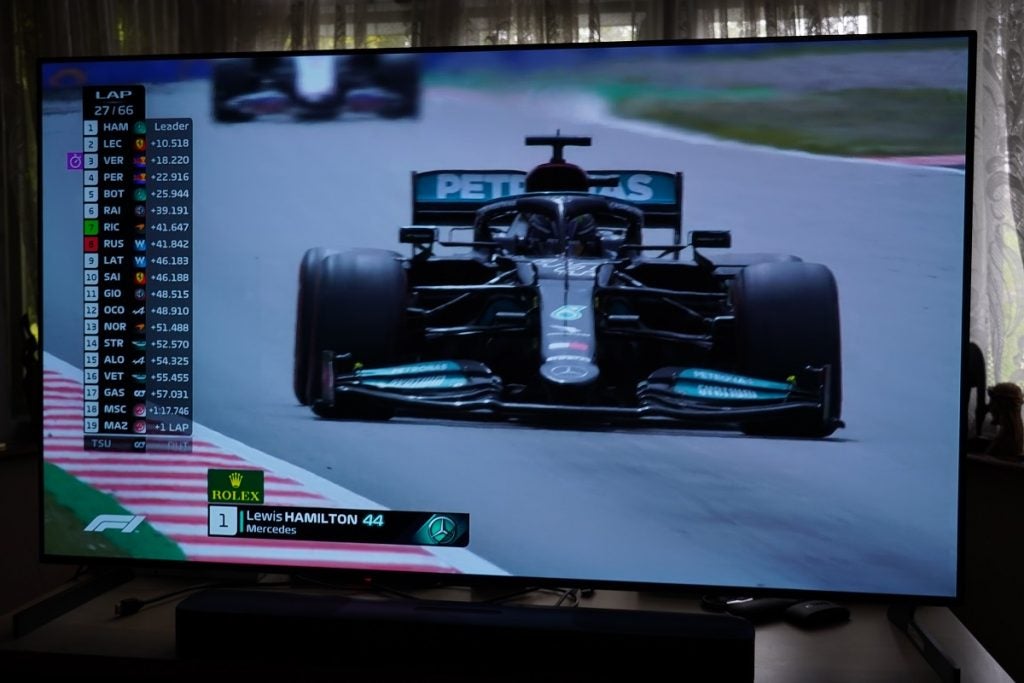
Cinematic Movement seems best suited for films, Natural for broadcast TV, and Smooth Movement for sports. There’s no one-size fits all, so the G1’s motion processing is solid rather than impressive, and for my two cents, still behind the likes of Panasonic and Sony (although I’ve not seen their latest TVs, yet).
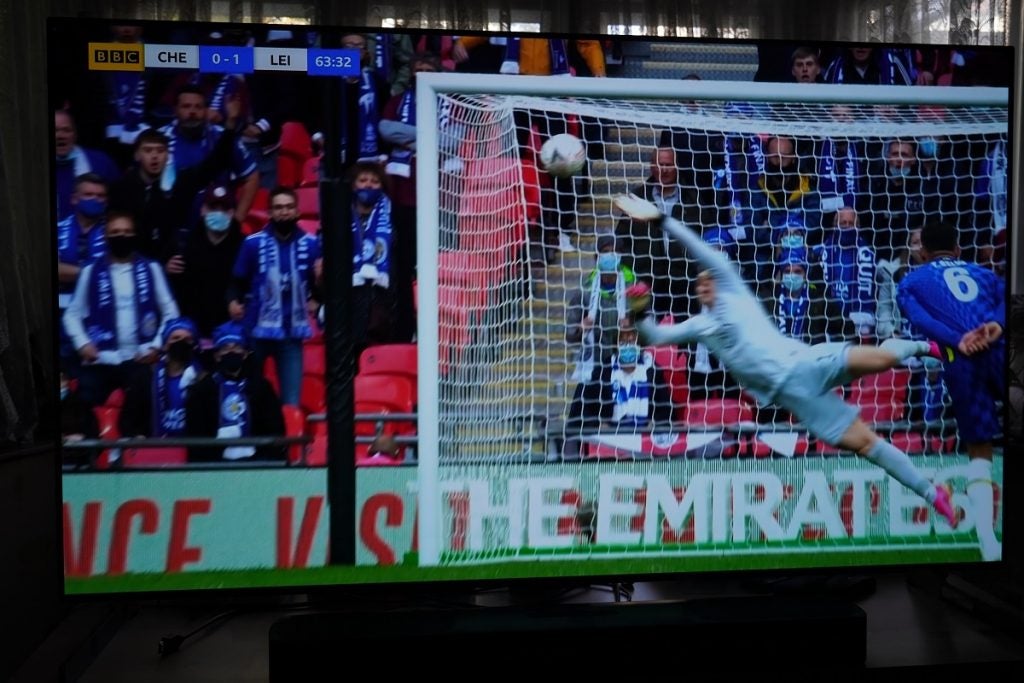
HDR covers HDR10, Broadcast HLG (supported by BBC iPlayer and Sky Q) and Dolby Vision HDR. The omission of HDR10+ means the G1 isn’t complete, which gives an edge to Panasonic and Philips’ fuller offering.
Much like the Philips 55OLED+935, there are a few changes I’d make to the Brightness settings; the out-of-the-box black levels mask some dark detail. A nudge by a few points for Dolby Vision and to around 60 for HDR10 content produces a more revealing image.

V’s costume In V for Vendetta feels shrouded in darkness until the brightness is nudged up. The scene in Black Panther where T’Challa ambushes a convoy offers more perceptible dark detail, with more foliage of the jungle visible and details of the guards and trucks better defined.
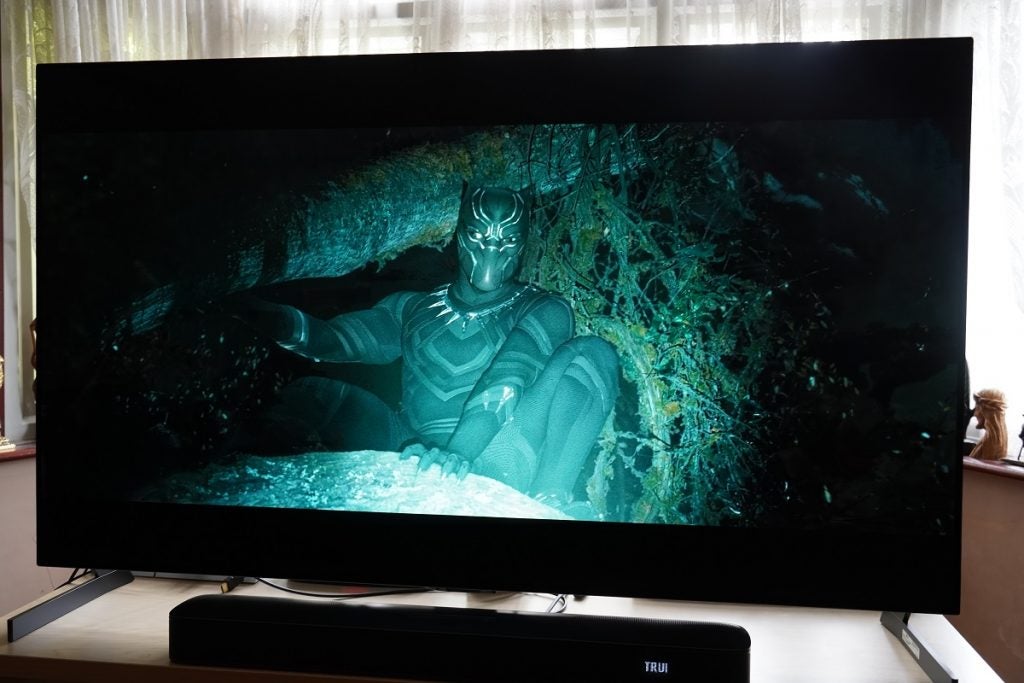
It’s with 4K HDR content – especially Dolby Vision – where the G1 shines brightest. Black levels are stupendously good in Jurassic World (4K HDR10), where the Indoraptor faces off against the velociraptors.
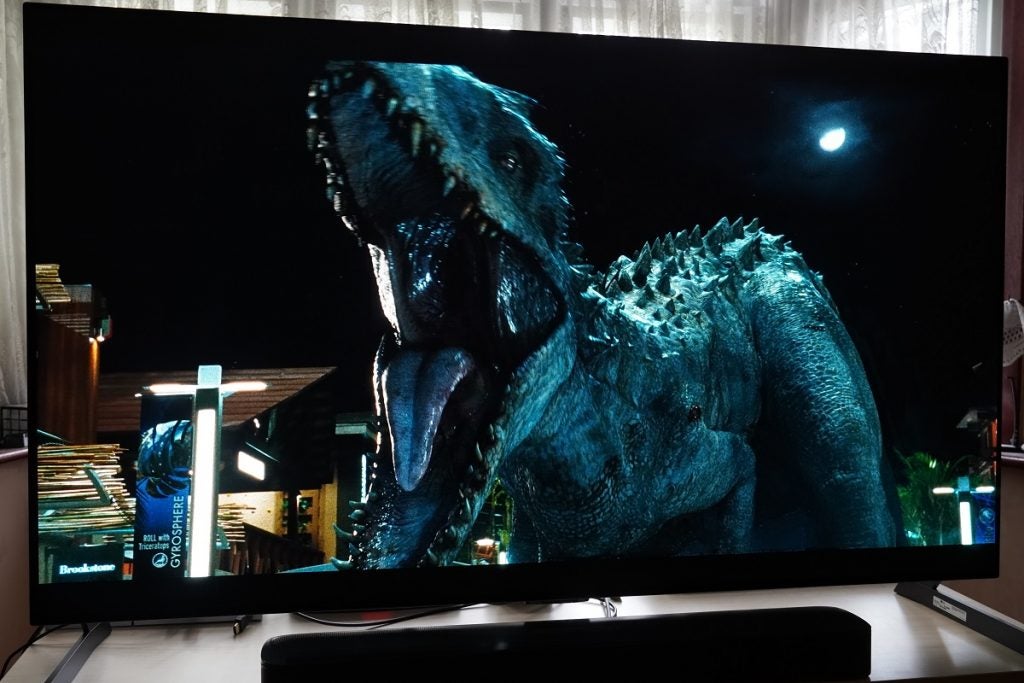
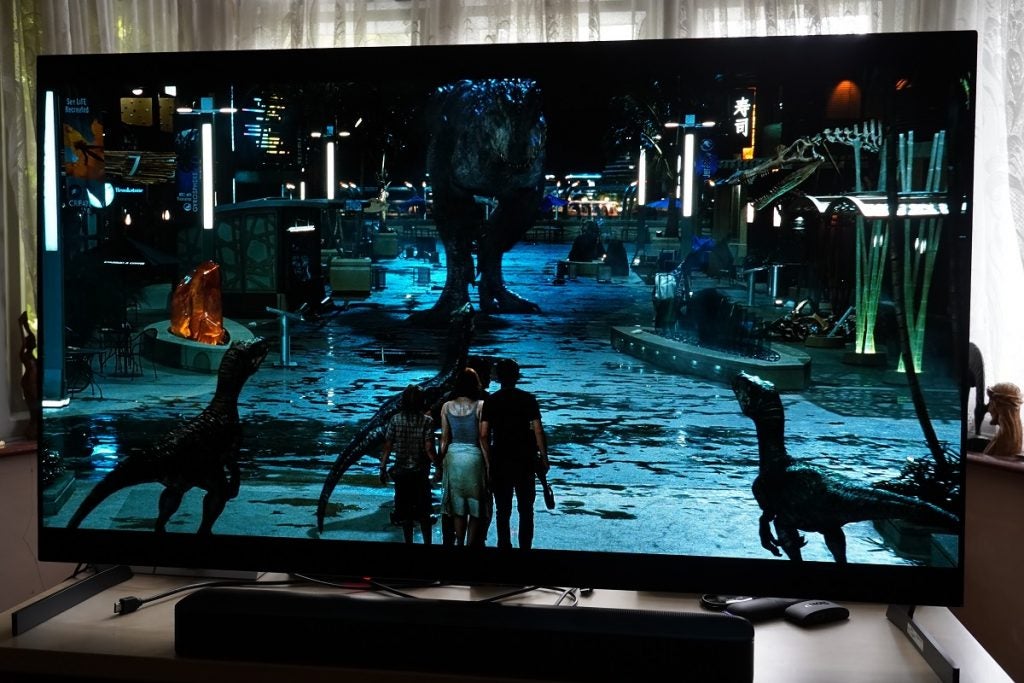
The inky blackness of the sky serves to accentuate the image’s three-dimensionality further, and the pixel-level dimming of OLEDs makes a precise image, especially with luminous sources (such as the lights of the wrecked shops). The film’s rich, saturated colours, as well as the depth of view 4K provides, brings with it a wonderful sense of immersion.
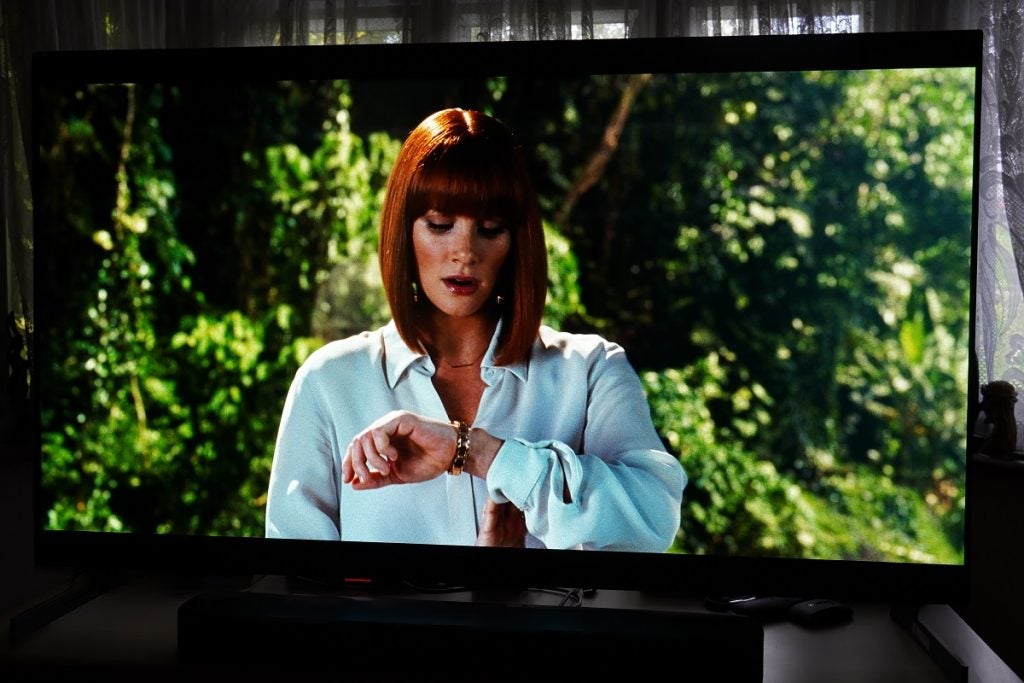
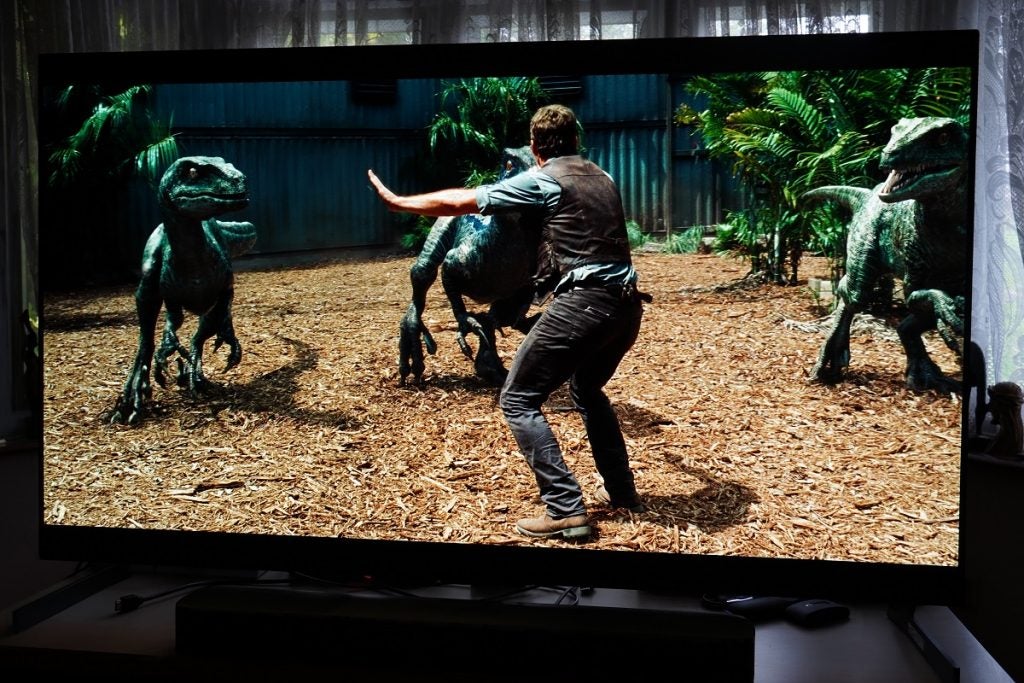
Highlights are impressively bright when contrasted with the G1’s deep blacks, producing a stunning combination in the opening of John Wick Chapter 3: Parabellum.
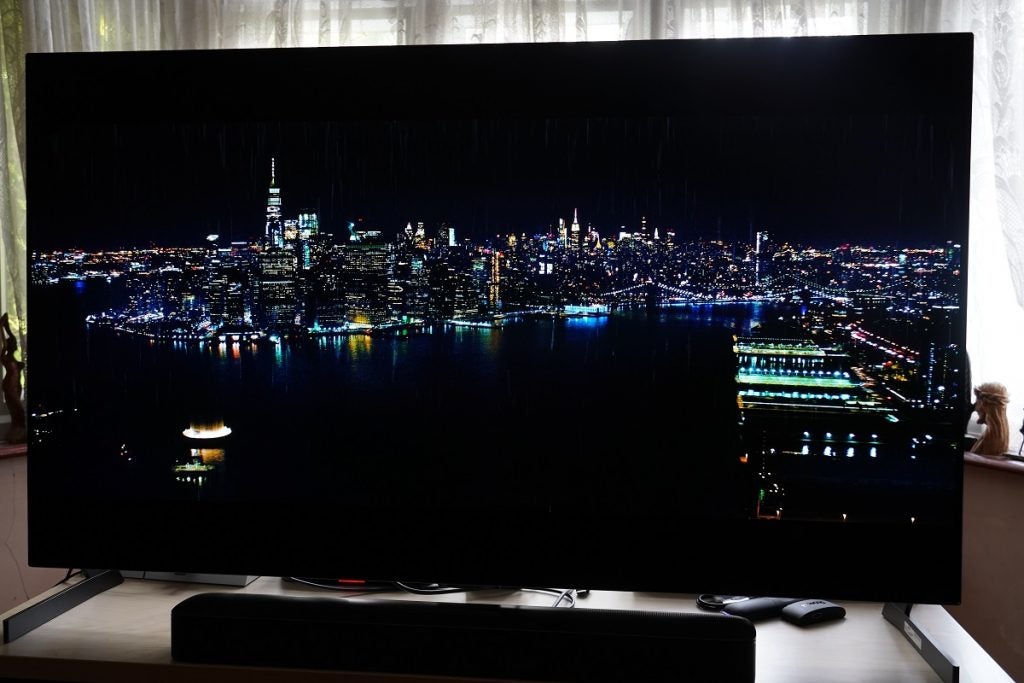
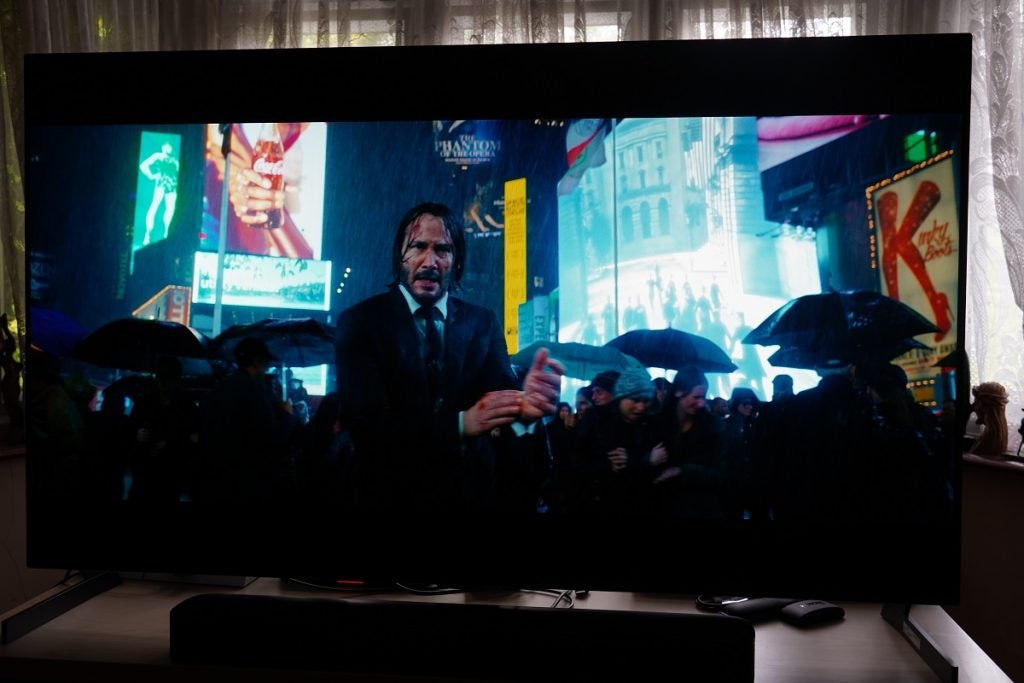
The lights of buildings in New York pit against the night-time sky are gorgeously displayed. The fight that ends the film between Wick and the two Shinobis is a dazzling showcase for the added luminance and intensity the Evo panel brings.
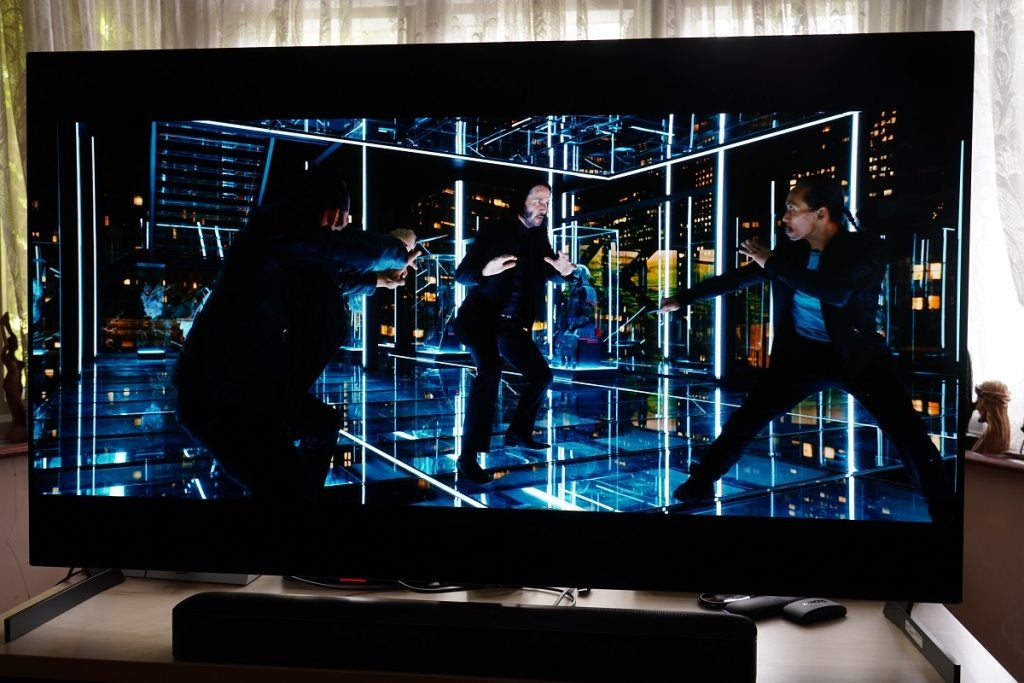
It’s the same across several films, from where Dutch faces off against his pursuer in Predator (the sparks do indeed spark), to where Batman ex-filtrates a criminal from a high-rise building in The Dark Knight, the glint of V’s daggers attract the eye in V for Vendetta or when Captain Marvel goes full supernova – watching 4K HDR films on this display is something of a guilty pleasure. You can’t take your eyes off the screen.
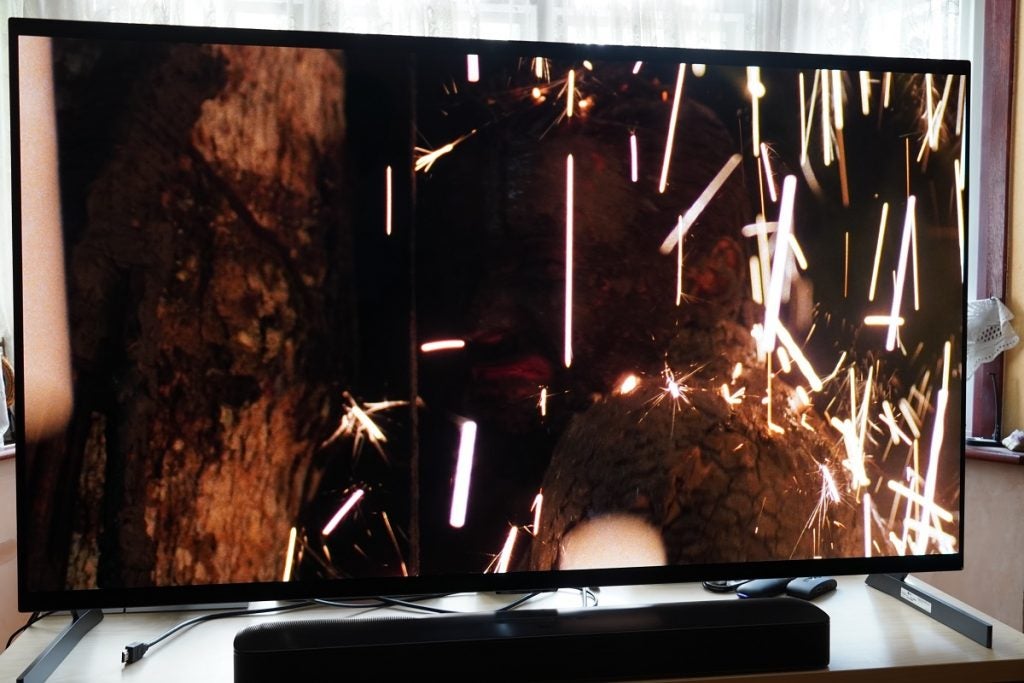
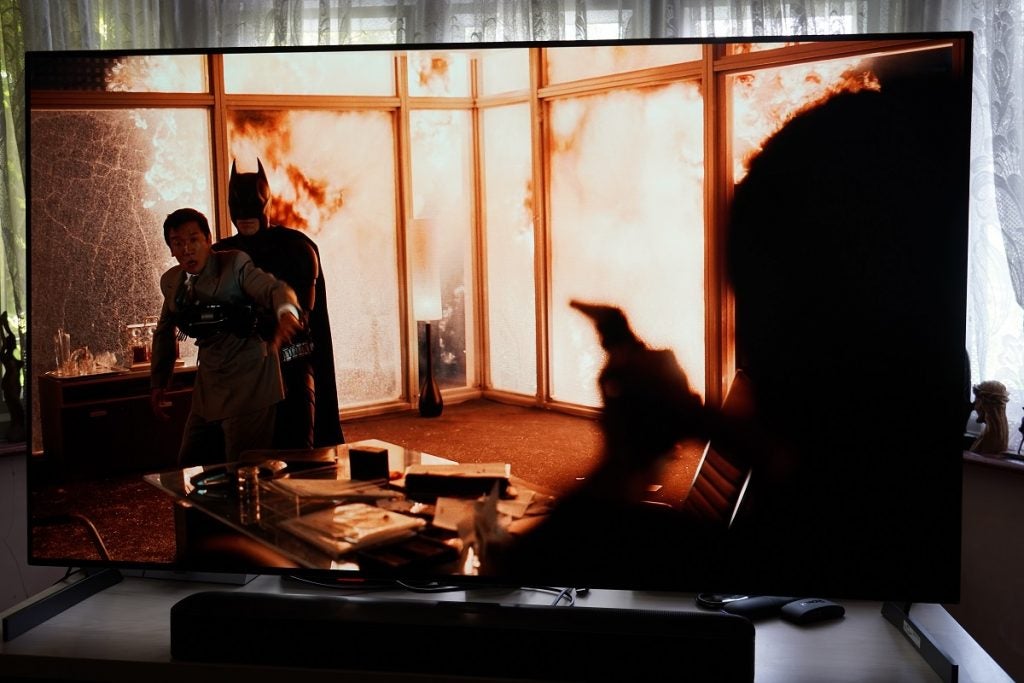
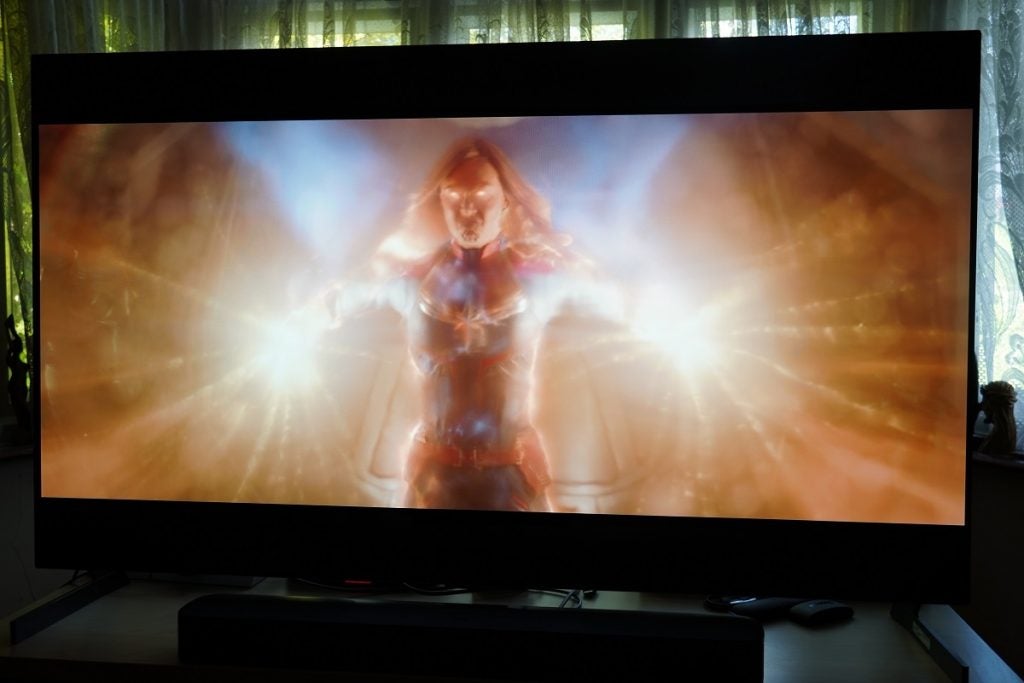
Contrast is impressively wide-ranging, and colours are dramatically conveyed, especially in Dolby Vision, the presence of which adds a lush, rich tone. It’s a close tussle between this and the Philips OLED+935 when it comes to their respective Dolby Vision performances, but I’d say the LG just edges it with its more natural look.
I’d also like to commend the Cinema Home picture mode, which I think is rather lovely. The golden tone it brings adds a sense of cinematic grandeur. A DVD of Kingdom of Heaven looks richer, while still maintaining a natural look. It’s quite exquisite.
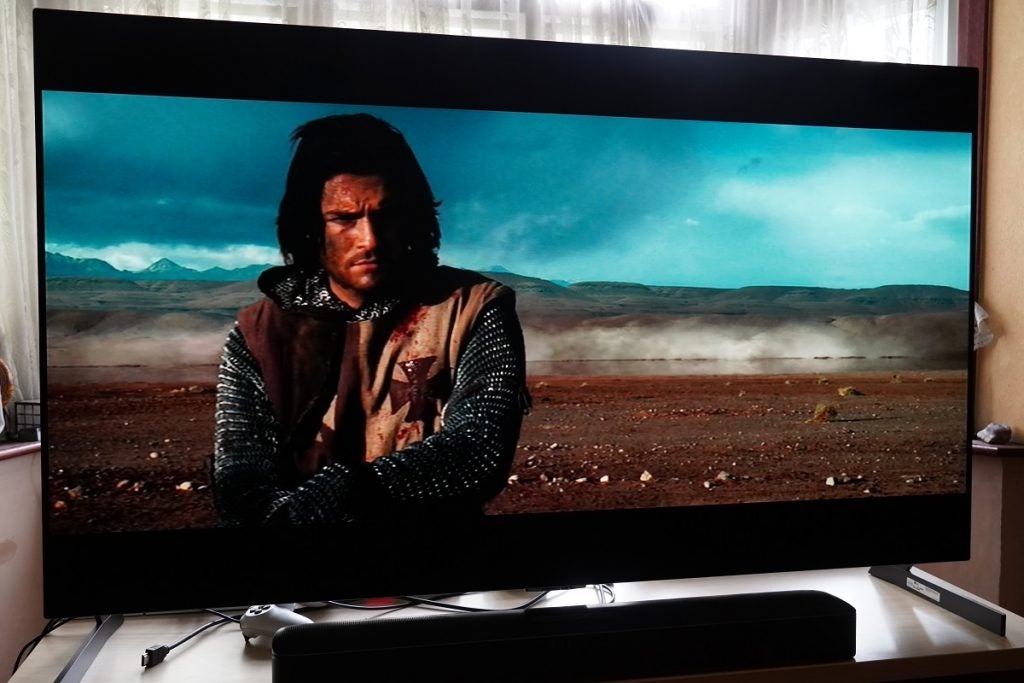
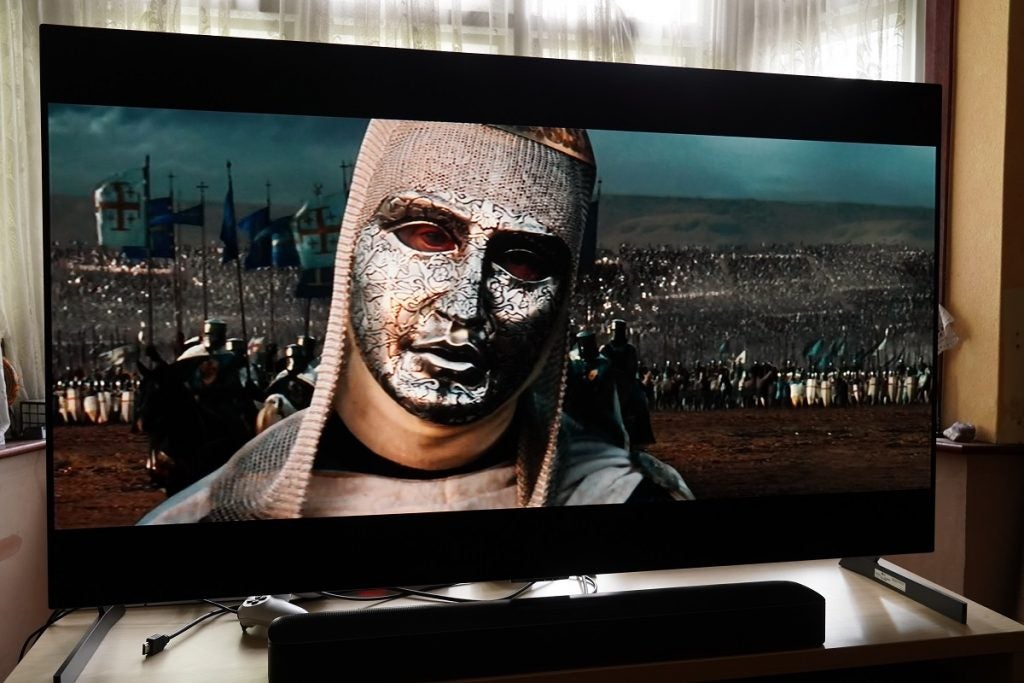
While not every aspect of the LG G1’s picture performance excels, there are aspects of it that take OLED displays to impressive places. It’s the best image quality I’ve reviewed on any LG OLED, and right up there with some of the best-looking images I’ve seen on any TV.
Sound quality
- AI Sound Pro produces traces of sibilance
- Sound is merely decent
- Plenty of ways to improve the sound
Amidst all that breathless praise, the LG G1’s audio performance is a rather qualified achievement. An advantage the Gallery OLED series has over the C series is its audio – its 4.2ch, 60W output is 20W more than the C1 OLED.
As usual, there’s an assortment of modes to choose from, but we need to talk about the AI Sound Pro mode.
AI Sound Pro adds virtual height channels to create a 5.1.2 up-mix for Dolby Atmos, and it works to a degree on streaming services. But with Black Panther it tended to sound small, constrained and lacking in depth, with the film’s soundtrack left diminished.
With broadcasts, AI Sound Pro can grate on the ears, and I’d absolutely recommend going through the acoustic tuning process to optimise this mode. Without it, watching Best Home Cook on BBC 2 delivered dialogue that was frequently sibilant and harsh, as if someone were whistling every few words.
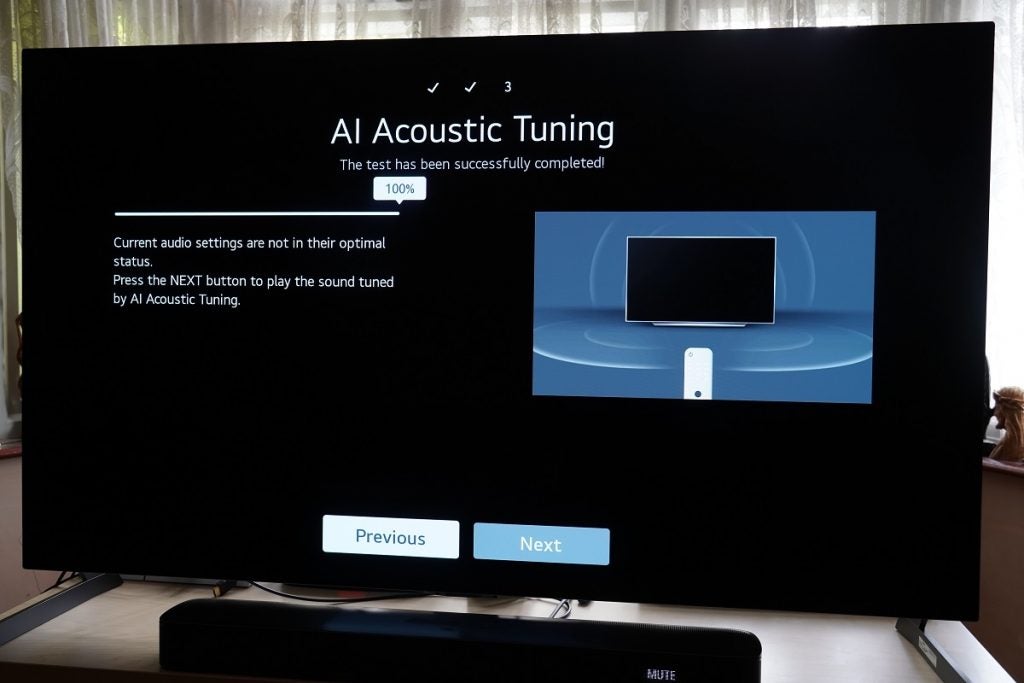
Performing the acoustic tuning reduced traces of sibilance, but voices in general lack a sense of weight and character. Voices are intelligible, but jumping to the Movie setting resulted in a much smoother and less ‘crisp’ experience that I much preferred.
So, while sound modes other than AI Sound Pro prove to be just acceptable, there are a few methods of improving the LG G1’s sound. There’s the G1 Soundbar due in July, which is a match for the OLED55G1 model but expressly designed to be wall-mounted.
WiSA 5.1 support allows for compatible speakers and subwoofers (Bang & Olufsen and Klipsch, to name a couple) to connect to the G1 over Wi-Fi, while the Bluetooth Surround Ready feature pairs the TV with Bluetooth speakers such as LG’s own XBOOM Go PL7 for surround sound assistance. You could always have a look at our best soundbars and Dolby Atmos soundbar for options.
Should you buy it?
If you’re in need of fantastic picture quality The LG G1’s images – from any source – are fantastic. The addition of the new Evo panel helps to increase brightness, and that brings a bit more intensity to HDR highlights for what is an alluring image.
If you’re not interested in wall-mounting The LG G1 ships with no stands. So, if you’re buying this TV, you’re purchasing it for the intent to plant it on a wall. Otherwise, those stands will cost extra, especially the Gallery Stand.
Verdict
The G1 is one of LG’s best OLEDs yet, from its minimalist design, fabulous picture quality and extensive features (gaming, in particular), the G1 OLED that oozes quality. Its preoccupation with wall-mounting means it isn’t for everyone, but this is another high-quality TV from LG.
FAQs
No it doesn’t. The LG G1 OLED Evo is designed to be wall-mounted, so if you want to use it on an existing stand you’ll need to purchase the feet or the free-standing Gallery Stand.

